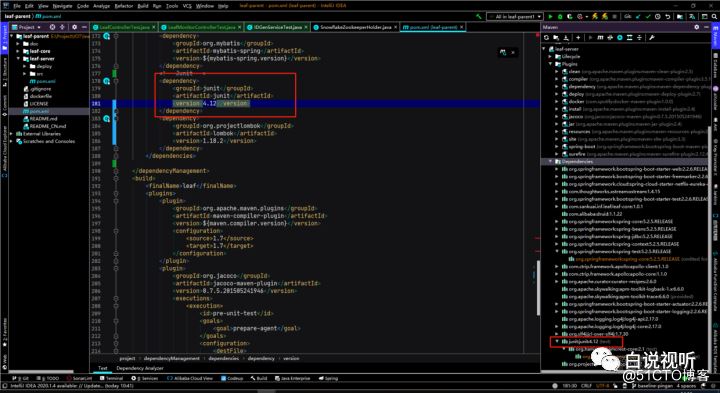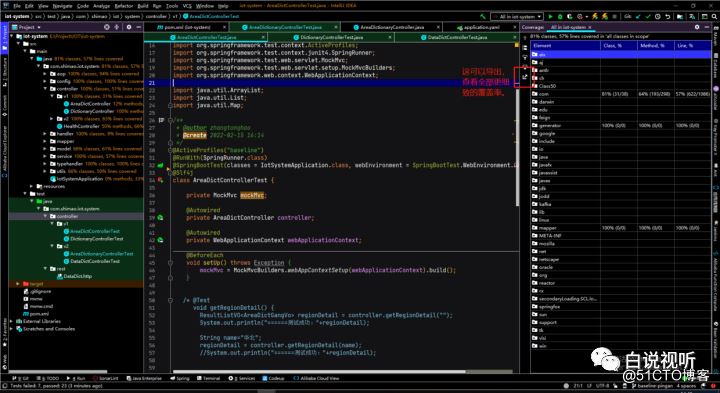springboot集成junit编写单元测试实战
目录
- 一:查看jar包版本号是否为junit4;
- 二:实战应用:
- 三:扩展
在做单元测试时,代码覆盖率常常被拿来作为衡量测试好坏的指标,甚至,用代码覆盖率来考核测试任务完成情况,比如,代码覆盖率必须达到80%或 90%。于是乎,测试人员费尽心思设计案例覆盖代码。用代码覆盖率来衡量,有利也有弊。
首先,让我们先来了解一下所谓的“代码覆盖率”。我找来了所谓的定义:代码覆盖率 = 代码的覆盖程度,一种度量方式。
一:查看jar包版本号是否为junit4;

junit自身注解:
@BeforeClass 全局只会执行一次,而且是第一个运行 @Before 在测试方法运行之前运行 @Test 测试方法 @After 在测试方法运行之后允许 @AfterClass 全局只会执行一次,而且是最后一个运行 @Ignore 忽略此方法
坑:为什么要先看版本号因为在junit5中@Before无效需要使用@BeforeEach;
二:实战应用:
idea快捷创建测试类:
1.首先要保证有test类,和main同级:

2.创建


编辑
添加图片注释,不超过 140 字(可选)

3.编写单元测试
@RunWith(SpringRunner.class):运行器指定 @SpringBootTest(classes =IotSystemApplication.class, webEnvironment =SpringBootTest.WebEnvironment.DEFINED_PORT) @Slf4j
可选参数
@ActiveProfiles("baseline") :表示项目启动参数为-baseline
@Transactional :回滚
import com.shimao.iot.common.entity.ResultListVO;
import com.shimao.iot.common.entity.ResultVO;
import com.shimao.iot.common.model.dict.vo.AreaDictGangVo;
import com.shimao.iot.common.model.dict.vo.AreaDictVo;
import com.shimao.iot.system.IotSystemApplication;
import lombok.extern.slf4j.Slf4j;
import org.junit.Assert;
import org.junit.jupiter.api.Test;
import org.junit.runner.RunWith;
import org.springframework.beans.factory.annotation.Autowired;
import org.springframework.boot.test.autoconfigure.web.servlet.AutoConfigureMockMvc;
import org.springframework.boot.test.context.SpringBootTest;
import org.springframework.test.context.ActiveProfiles;
import org.springframework.test.context.junit4.SpringRunner;
import org.springframework.test.web.servlet.MockMvc;
import org.springframework.transaction.annotation.Transactional;
import org.springframework.web.context.WebApplicationContext;
import java.util.ArrayList;
import java.util.List;
import java.util.Map;
/**
* @author zhangtonghao
* @create 2022-02-16 11:00
*/
@ActiveProfiles("baseline")
@RunWith(SpringRunner.class)
@SpringBootTest(classes =IotSystemApplication.class, webEnvironment =SpringBootTest.WebEnvironment.DEFINED_PORT)
@AutoConfigureMockMvc
@Transactional
@Slf4j
class AreaDictionaryControllerTest {
private MockMvc mockMvc;
@Autowired
private AreaDictionaryController controller;
@Autowired
private WebApplicationContext webApplicationContext;
/*@BeforeEach 初始化数据
void setUp() throws Exception {
mockMvc = MockMvcBuilders.webAppContextSetup(webApplicationContext).build();
}*/
@Test
void getRegionDetail() {
ResultListVO<AreaDictGangVo> regionDetail =controller.getRegionDetail("");
System.out.println("======测试成功:" +regionDetail);
String name ="华北";
regionDetail =controller.getRegionDetail(name);
Assert.assertNotNull(regionDetail);
System.out.println("======测试成功:" +regionDetail);
}
@Test
void testGetRegionDetail() {
Long areaCode =100001L;
ResultVO<AreaDictVo> regionDetail =controller.getRegionDetail(areaCode);
Assert.assertNotNull(regionDetail);
System.out.println("======测试成功:" +regionDetail);
}
@Test
void getAreaTypeDetails() {
Integer areaCode =100001;
ResultListVO<AreaDictVo> resultListVO =controller.getAreaTypeDetails(areaCode);
Assert.assertNotNull(resultListVO);
System.out.println("======测试成功:" +resultListVO);
}
@Test
void getSubrangeDetail() {
Long areaCode =100001L;
ResultListVO<AreaDictVo> resultListVO =controller.getSubrangeDetail(areaCode);
Assert.assertNotNull(resultListVO);
System.out.println("======测试成功:" +resultListVO);
}
@Test
void getGangDetail() {
Long areaCode =100001L;
ResultVO<AreaDictGangVo> resultListVO =controller.getGangDetail(areaCode);
Assert.assertNotNull(resultListVO);
System.out.println("======测试成功:" +resultListVO);
}
@Test
void findAreaDictList() {
Long areaCode =100001L;
List<Long> areaCodes =new ArrayList<>();
areaCodes.add(areaCode);
List<AreaDictVo> resultListVO =controller.findAreaDictList(areaCodes);
Assert.assertNotNull(resultListVO);
System.out.println("======测试成功:" +resultListVO);
}
@Test
void findAreaDictParentMap() {
Long areaCode =100001L;
List<Long> areaCodes =new ArrayList<>();
areaCodes.add(areaCode);
Map<Long, AreaDictVo> resultListVO =controller.findAreaDictParentMap(areaCodes);
Assert.assertNotNull(resultListVO);
System.out.println("======测试成功:" +resultListVO);
}
@Test
void queryProvinceAndCity() {
ResultListVO<AreaDictVo> resultListVO =controller.queryProvinceAndCity();
Assert.assertNotNull(resultListVO);
}
}
4.启动测试:正常启动我就不说了说下如何查看覆盖率启动
首先需要安装junit插件,然后启动:


注意点:其实书写单元测试没有什么技巧,只有一个参数问题;你能保证参数正确就可以让测试覆盖率更高。这都需要看代码实现,所以不用妄想一键生成覆盖率达到百分之80啥的了,不存在的。下面还有一些可用的技巧和讲解,着急的可以不用看直接回去写代码去了。
三:扩展
某些对象类的单元测试:
/**
* 调用VO DTO POJO MODEL等服务通用方法
*/
@Test
public void testDto() {
HeartDtoheartDto = newHeartDto();
testGetAndSet(heartDto);
heartDto.toString();
heartDto.equals(newObject());
heartDto.hashCode();
AlllogDtoallLogDto = newAlllogDto();
testGetAndSet(allLogDto);
allLogDto.toString();
allLogDto.equals(newObject());
allLogDto.hashCode();
}
/**
* JavaBean属性名要求:前两个字母要么都大写,要么都小写
* 对于首字母是一个单词的情况,要么过滤掉,要么自己拼方法名
* f.isSynthetic()过滤合成字段
*/
private static void testGetAndSet(Object t) {
try {
Class modelClass =t.getClass();
Object obj =modelClass.newInstance();
Field[] fields =modelClass.getDeclaredFields();
for (Fieldf :fields) {
if (f.getName().equals("aLike") ||f.isSynthetic()) {
continue;
}
PropertyDescriptorpd = newPropertyDescriptor(f.getName(), modelClass);
Methodget =pd.getReadMethod();
Methodset =pd.getWriteMethod();
set.invoke(obj, get.invoke(obj));
}
} catch (Exception e) {
e.printStackTrace();
}
}
断言列表:
-------------->assertTrue(String message, boolean condition) 要求condition == true -------------->assertFalse(String message, boolean condition) 要求condition == false -------------->assertEquals(String message, XXX expected,XXX actual) 要求expected期望的值能够等于actual -------------->assertArrayEquals(String message, XXX[] expecteds,XXX [] actuals) 要求expected.equalsArray(actual) -------------->assertNotNull(String message, Object object) 要求object!=null -------------->assertNull(String message, Object object) 要求object==null -------------->assertSame(String message, Object expected, Object actual) 要求expected == actual -------------->assertNotSame(String message, Object unexpected,Object actual) 要求expected != actual -------------->assertThat(String reason, T actual, Matcher matcher) 要求matcher.matches(actual) == true -------------->fail(String message) 要求执行的目标结构必然失败,同样要求代码不可达,即是这个方法在程序运行后不会成功返回,如果成功返回了则报错
代码覆盖程度的度量方式是有很多种的,这里介绍一下最常用的几种:
1. 语句覆盖(StatementCoverage)
又称行覆盖(LineCoverage),段覆盖(SegmentCoverage),基本块覆盖(BasicBlockCoverage),这是最常用也是最常见的一种覆盖方式,就是度量被测代码中每个可执行语句是否被执行到了。这里说的是“可执行语句”,因此就不会包括像C++的头文件声明,代码注释,空行,等等。非常好理解,只统计能够执行的代码被执行了多少行。需要注意的是,单独一行的花括号{} 也常常被统计进去。语句覆盖常常被人指责为“最弱的覆盖”,它只管覆盖代码中的执行语句,却不考虑各种分支的组合等等。假如你的上司只要求你达到语句覆盖,那么你可以省下很多功夫,但是,换来的确实测试效果的不明显,很难更多地发现代码中的问题。
2. 判定覆盖(DecisionCoverage)
又称分支覆盖(BranchCoverage),所有边界覆盖(All-EdgesCoverage),基本路径覆盖(BasicPathCoverage),判定路径覆盖(Decision-Decision-Path)。它度量程序中每一个判定的分支是否都被测试到了。这句话是需要进一步理解的,应该非常容易和下面说到的条件覆盖混淆。因此我们直接介绍第三种覆盖方式,然后和判定覆盖一起来对比,就明白两者是怎么回事了。
3. 条件覆盖(ConditionCoverage)
它度量判定中的每个子表达式结果true和false是否被测试到了。
4. 路径覆盖(PathCoverage)
又称断言覆盖(PredicateCoverage)。它度量了是否函数的每一个分支都被执行了。这句话也非常好理解,就是所有可能的分支都执行一遍,有多个分支嵌套时,需要对多个分支进行排列组合,可想而知,测试路径随着分支的数量指数级别增加。
到此这篇关于springboot集成junit编写单元测试实战的文章就介绍到这了,更多相关springboot junit单元测试内容请搜索我们以前的文章或继续浏览下面的相关文章希望大家以后多多支持我们!

